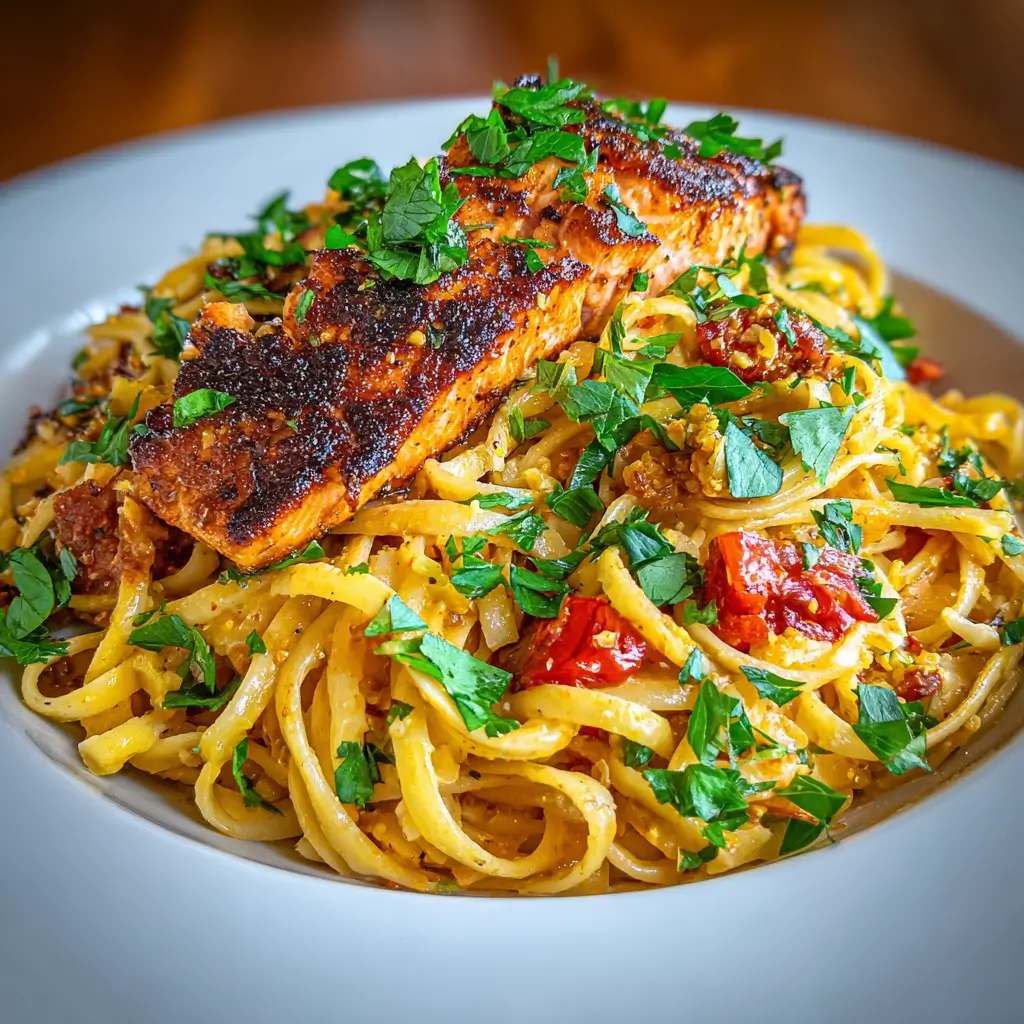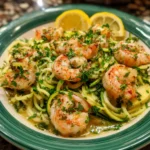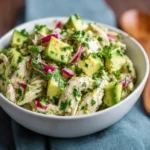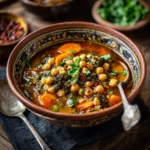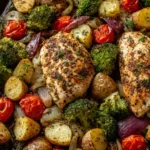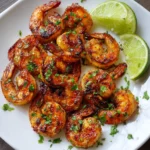Cajun Salmon Pasta: A Flavor-Packed Fusion of Creamy, Spicy, and Savory Delights
Indulge in a dish that brings together the bold flavors of Cajun seasoning with the rich, buttery texture of fresh salmon and the comforting embrace of al dente pasta. Cajun Salmon Pasta is not just a meal—it’s a culinary experience that marries Southern Creole influences with modern comfort food elegance. Whether you’re cooking for a weeknight dinner or impressing guests at a weekend gathering, this recipe delivers on taste, nutrition, and visual appeal. With its vibrant colors, aromatic spices, and luxurious creamy sauce, it’s no wonder this dish has gained popularity across home kitchens and gourmet restaurants alike.
The History Behind Cajun Cuisine and Its Modern Evolution
Cajun cuisine traces its roots to the Acadian people—French settlers expelled from Canada (present-day Nova Scotia) in the 18th century who eventually settled in southern Louisiana. Their rustic, hearty cooking style evolved using local ingredients such as crawfish, rice, sausage, and an abundance of spices. The hallmark of Cajun food lies in its “holy trinity” of diced onions, bell peppers, and celery, along with robust seasonings like paprika, cayenne pepper, garlic, and thyme.
While traditional Cajun dishes include jambalaya, gumbo, and boudin, modern interpretations have embraced fusion concepts. Enter Cajun Salmon Pasta—a contemporary twist that combines the deep, smoky heat of Cajun spice rubs with the delicate richness of Atlantic or wild-caught salmon. This dish exemplifies how global palates are embracing regional American flavors while adapting them to healthier, more versatile formats. By incorporating elements like whole wheat pasta, Greek yogurt or light cream, and fresh vegetables, today’s version stays true to tradition while appealing to health-conscious diners.
Ingredients Breakdown: What Makes This Dish Shine?
The magic of Cajun Salmon Pasta lies in its balance of textures and tastes. Each ingredient plays a crucial role:
- Salmon Fillets: Rich in omega-3 fatty acids and protein, salmon adds a buttery, flaky element that pairs beautifully with spicy seasonings. Opt for skin-on fillets for extra crispiness when seared.
- Pasta: Traditionally fettuccine or penne is used, but any short-cut pasta works well. Whole grain or legume-based pastas offer higher fiber and protein content for a nutritious upgrade.
- Cajun Seasoning: A blend typically consisting of paprika, garlic powder, onion powder, cayenne pepper, black pepper, oregano, and thyme. You can use store-bought mixes or make your own for full control over salt and spice levels.
- Heavy Cream or Half-and-Half: Provides a luscious base for the sauce. For a lighter option, substitute with coconut milk, evaporated milk, or cashew cream.
- Garlic: Fresh minced garlic enhances depth and aroma, essential for building flavor layers.
- Butter and Olive Oil: Butter contributes richness; olive oil helps raise the smoke point during searing and adds heart-healthy monounsaturated fats.
- Chicken or Vegetable Broth: Adds savory complexity and thins the sauce slightly without diluting flavor.
- Cherry Tomatoes: Burst with sweetness and acidity, balancing the heat from the Cajun spice.
- Red Bell Pepper: Offers crunch and natural sugars that caramelize slightly when sautéed.
- Onion: White or yellow onion provides the foundational sweetness and structure.
- Spinach or Kale: Adds color, nutrients, and a mild earthy note. Wilted greens integrate seamlessly into the creamy sauce.
- Lemon Juice: Brightens the entire dish, cutting through the richness and enhancing other flavors.
- Parmesan Cheese: Salty, nutty, and umami-rich—this elevates the creaminess and adds a gourmet touch.
- Fresh Herbs (Parsley or Basil): Used as garnish for freshness and visual appeal.
Step-by-Step Recipe: Crafting the Perfect Cajun Salmon Pasta
- Prepare the Salmon: Pat 4 salmon fillets (about 6 oz each) dry with paper towels. Generously coat both sides with 2–3 tablespoons of Cajun seasoning. Let sit for 10–15 minutes at room temperature to allow flavors to penetrate.
- Cook the Pasta: Bring a large pot of salted water to a boil. Add 12 oz of penne or fettuccine and cook according to package instructions until al dente. Reserve 1 cup of pasta water before draining. Set aside.
- Sear the Salmon: Heat 1 tablespoon olive oil and 1 tablespoon butter in a large skillet over medium-high heat. Once hot, place salmon fillets skin-side down (if applicable). Sear for 5–6 minutes until deeply golden and crispy. Flip carefully and cook for another 3–4 minutes, depending on thickness. Remove from pan and set aside to rest. Flake into large chunks once cooled slightly.
- Build the Sauce Base: In the same skillet (to retain flavor), add 1 tablespoon olive oil if needed. Sauté 1 diced onion, 1 sliced red bell pepper, and ½ cup halved cherry tomatoes for 5–6 minutes until softened and slightly caramelized. Add 4 cloves minced garlic and cook for 30 seconds until fragrant.
- Create the Creamy Mixture: Pour in 1 cup chicken or vegetable broth, scraping up any browned bits from the bottom of the pan. Stir in 1 cup heavy cream (or alternative), ½ cup grated Parmesan cheese, 1 tablespoon lemon juice, and 1 teaspoon additional Cajun seasoning (adjust to taste). Simmer gently for 4–5 minutes until slightly thickened.
- Incorporate Greens: Add 2 cups fresh spinach or chopped kale and stir until wilted—about 2 minutes.
- Combine Everything: Add the drained pasta to the skillet and toss thoroughly to coat. If the sauce is too thick, gradually add reserved pasta water ¼ cup at a time until desired consistency is reached.
- Add the Salmon: Gently fold in the flaked salmon, being careful not to break it apart too much. Warm through for 1–2 minutes.
- Finish and Serve: Taste and adjust seasoning with salt, pepper, lemon juice, or extra Cajun spice. Garnish with chopped fresh parsley or basil and a final sprinkle of Parmesan.
Pro Tips for Mastering Cajun Salmon Pasta
- Don’t Overcook the Salmon: It continues to cook after removal from heat. Aim for medium-rare to medium doneness for optimal juiciness.
- Bloom the Spices: For deeper flavor, briefly toast the Cajun seasoning in the pan before adding liquids.
- Use Reserved Pasta Water: The starchy liquid helps emulsify the sauce and bind it to the pasta strands.
- Rest the Salmon Before Flaking: Allows juices to redistribute and prevents it from falling apart too much.
- Balance the Heat: If the dish becomes too spicy, stir in a spoonful of sour cream, plain Greek yogurt, or a pinch of sugar to mellow the burn.
- Prep Ahead: Chop all vegetables and measure ingredients beforehand (mise en place) since the cooking process moves quickly.
- Skillet Size Matters: Use a wide, deep skillet or Dutch oven to prevent overcrowding and ensure even cooking.
Variations and Customizations: Make It Your Own
Cajun Salmon Pasta is incredibly adaptable. Here are some creative ways to customize the recipe:
- Vegetarian Version: Replace salmon with grilled portobello mushrooms, chickpeas, or tofu marinated in Cajun spice.
- Dairy-Free Option: Use coconut milk instead of cream, nutritional yeast instead of Parmesan, and vegan butter.
- Gluten-Free Adaptation: Choose gluten-free pasta made from rice, corn, or quinoa. Ensure broth and seasoning blends are certified GF.
- Seafood Swap: Try shrimp, scallops, or crab meat for a different protein profile. Shrimp cooks faster—add them right before the cream.
- Low-Carb/Keto Friendly: Substitute pasta with zucchini noodles (zoodles), spaghetti squash, or shirataki noodles. Increase healthy fats with avocado or olive oil.
- Extra Veggies: Add diced zucchini, broccoli florets, artichoke hearts, or sun-dried tomatoes for added nutrition and color.
- Spice Level Control: Reduce or omit cayenne pepper for mild versions. Add hot sauce like Crystal or Tabasco at the end for extra kick.
- Herb Twists: Swap parsley for cilantro or dill for a fresh, unique flavor profile.
- Smoked Salmon Variation: Use smoked salmon flakes for a briny, intense flavor—great for brunch-style presentations.
- Cream Alternatives: Blend silken tofu with vegetable broth for a high-protein, plant-based creamy base.
Health Considerations and Nutritional Value
Cajun Salmon Pasta isn’t just delicious—it can be part of a balanced diet when prepared thoughtfully. Here’s a breakdown of its nutritional benefits:
- Omega-3 Fatty Acids: Salmon is one of the best sources of EPA and DHA, which support brain health, reduce inflammation, and improve heart function.
- High-Quality Protein: Essential for muscle repair and satiety. A single serving provides around 30–40 grams of protein.
- Complex Carbohydrates: Whole grain pasta offers sustained energy and dietary fiber (up to 6–8g per serving).
- Antioxidant-Rich Vegetables: Bell peppers, tomatoes, and spinach deliver vitamins A, C, K, folate, and potassium.
- Healthy Fats: Olive oil and salmon contribute unsaturated fats that promote cardiovascular wellness.
- Calcium and Phosphorus: From dairy components like Parmesan and cream, supporting bone health.
Nutrition Estimate (Per Serving, ~1/4 of recipe):
- Calories: 650–750 (varies by ingredients)
- Protein: 38g
- Fat: 32g (mostly unsaturated)
- Saturated Fat: 10g
- Carbohydrates: 55g
- Fiber: 6g
- Sugar: 7g (natural from vegetables)
- Sodium: 800–1000mg (can be reduced with low-sodium broth and homemade seasoning)
To make it healthier:
- Use low-fat milk or evaporated milk instead of heavy cream.
- Reduce cheese quantity or use stronger-flavored aged varieties for less volume.
- Increase vegetable-to-pasta ratio for lower glycemic impact.
- Choose wild-caught salmon over farmed for better omega-3 to omega-6 ratios.
Full Ingredients List
- 12 oz (340g) penne, fettuccine, or preferred pasta
- 4 (6 oz each) salmon fillets, skin-on or off
- 3–4 tbsp Cajun seasoning (homemade or store-bought)
- 2 tbsp olive oil, divided
- 2 tbsp unsalted butter, divided
- 1 medium yellow onion, diced
- 1 red bell pepper, sliced
- 1 cup cherry tomatoes, halved
- 4 cloves garlic, minced
- 1 cup low-sodium chicken or vegetable broth
- 1 cup heavy cream (or substitute)
- ½ cup grated Parmesan cheese, plus more for serving
- 1 tbsp fresh lemon juice
- 2 cups fresh baby spinach or chopped kale
- Salt and freshly ground black pepper, to taste
- ¼ cup fresh parsley or basil, chopped (for garnish)
- Lemon wedges (optional, for serving)
Detailed Directions
- Season the Salmon: Dry the salmon fillets thoroughly and apply Cajun seasoning evenly on both sides. Allow to marinate briefly while preparing other ingredients.
- Cook the Pasta: Boil salted water in a large pot. Cook pasta until just al dente. Drain, reserving 1 cup of starchy water. Keep warm.
- Sear the Salmon: Heat 1 tbsp olive oil and 1 tbsp butter in a large nonstick or cast-iron skillet over medium-high heat. Place salmon in the pan and cook skin-side down for 5–6 minutes until golden and releases easily. Flip and cook 3–4 minutes more. Transfer to a plate, flake gently, and cover to keep warm.
- Sauté Aromatics: In the same pan, add remaining oil if needed. Add onions and bell peppers; cook 5 minutes until soft. Stir in cherry tomatoes and cook 2 more minutes. Add garlic and sauté 30 seconds until fragrant.
- Make the Sauce: Pour in broth and deglaze, scraping up browned bits. Stir in cream, Parmesan, lemon juice, and 1 tsp Cajun seasoning. Simmer 4–5 minutes until sauce coats the back of a spoon.
- Add Greens: Fold in spinach or kale and cook until wilted—about 2 minutes.
- Combine Pasta: Add cooked pasta and toss well. Gradually add reserved pasta water to loosen the sauce as needed.
- Incorporate Salmon: Gently stir in flaked salmon and heat through for 1–2 minutes. Avoid vigorous stirring to preserve texture.
- Final Adjustments: Taste and season with salt, pepper, extra lemon, or more spice. Remove from heat.
- Serve Immediately: Divide among warm bowls. Top with fresh herbs, extra Parmesan, and lemon wedges on the side.
Frequently Asked Questions (FAQ)
Can I bake the salmon instead of pan-searing?
Yes! Preheat oven to 400°F (200°C). Place seasoned salmon on a lined baking sheet and bake for 12–15 minutes until flaky. Pan-searing gives better crust and flavor, but baking is easier and less messy.
How do I prevent the sauce from breaking or curdling?
Avoid boiling the cream sauce vigorously. Keep heat at medium-low when adding dairy, and never let it come to a rapid boil. If using lemon juice, add it off-heat or at the very end.
Can I make this ahead of time?
Best served fresh. However, you can prep components separately: cook pasta, make sauce base, and sear salmon up to a day in advance. Reheat gently and combine before serving.
Is Cajun seasoning the same as Creole seasoning?
They’re similar but not identical. Cajun seasoning usually contains more garlic, cayenne, and black pepper with no salt. Creole often includes herbs like oregano and thyme and may have salt. Interchangeable in most recipes.
Can I freeze leftovers?
Not recommended due to the dairy-based sauce, which may separate upon thawing. Store in the refrigerator for up to 2 days and reheat gently on the stove with a splash of broth or cream.
What wine pairs well with Cajun Salmon Pasta?
A chilled glass of unoaked Chardonnay, Sauvignon Blanc, or Pinot Gris complements the spice and creaminess. For red lovers, a light Pinot Noir works if not too spicy.
Can I use frozen salmon?
Yes, but thaw it slowly in the refrigerator overnight. Never cook frozen salmon directly unless specified, as it leads to uneven texture.
Why is my pasta mushy?
Overcooking or leaving pasta in hot water too long causes mushiness. Always cook al dente and drain immediately. Rinse only if making cold pasta salad.
Summary
Cajun Salmon Pasta combines flaky, spice-crusted salmon with creamy, tomato-kissed sauce and tender pasta for a restaurant-worthy dish that’s surprisingly simple to make at home. Packed with bold flavors, nutritious ingredients, and endless customization options, it’s a satisfying meal that celebrates the vibrant spirit of Cajun cooking with a modern twist.
